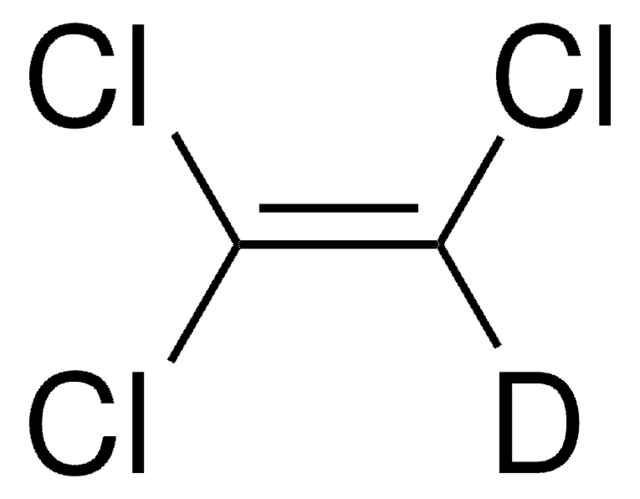Key Documents
251402
Trichloroethylene
ACS reagent, ≥99.5%
Synonim(y):
TCE, Trichloroethene
About This Item
Polecane produkty
klasa czystości
ACS reagent
Poziom jakości
gęstość pary
4.5 (vs air)
ciśnienie pary
61 mmHg ( 20 °C)
Próba
≥99.5%
Postać
liquid
temp. samozapłonu
770 °F
zanieczyszczenia
Free halogens, passes test
≤0.0001 meq/g Titr. acid
≤0.0003 meq/g Titr. base
≤0.02% water
pozostałość po odparowaniu
≤0.001%
kolor
APHA: ≤10
współczynnik refrakcji
n20/D 1.476 (lit.)
tw
86.7 °C (lit.)
mp
−84.8 °C (lit.)
gęstość
1.463 g/mL at 25 °C (lit.)
ślady kationów
heavy metals (as Pb): ≤1 ppm
ciąg SMILES
Cl\C=C(\Cl)Cl
InChI
1S/C2HCl3/c3-1-2(4)5/h1H
Klucz InChI
XSTXAVWGXDQKEL-UHFFFAOYSA-N
Szukasz podobnych produktów? Odwiedź Przewodnik dotyczący porównywania produktów
Opis ogólny
Zastosowanie
- As a solvent in the C- and O-glycosylation reactions of tetrahydropyran acetals and 2-deoxyglucopyranosides to prepare SN2 products.
- In the chemical industry for the synthesis of polyvinyl chloride, chloroacetic acid, hydrofluorocarbons, pharmaceuticals, insecticides, fungicides, fire retardants, fertilizer, and synthetic rubber.
- As a starting material in the synthesis of dichloroacetylene.
- As a reagent in the preparation of alkynic ethers.
- As a reagent for ethynylation and vinylation process.
Hasło ostrzegawcze
Danger
Zwroty wskazujące rodzaj zagrożenia
Zwroty wskazujące środki ostrożności
Klasyfikacja zagrożeń
Aquatic Chronic 3 - Carc. 1B - Eye Irrit. 2 - Muta. 2 - Skin Irrit. 2 - Skin Sens. 1B - STOT SE 3
Organy docelowe
Central nervous system
Kod klasy składowania
6.1D - Non-combustible acute toxic Cat.3 / toxic hazardous materials or hazardous materials causing chronic effects
Klasa zagrożenia wodnego (WGK)
WGK 3
Temperatura zapłonu (°F)
closed cup - does not flash
Temperatura zapłonu (°C)
closed cup - does not flash
Wykazy regulacyjne
Wykazy regulacyjne dotyczą głównie produktów chemicznych. Można w nich podawać ograniczoną liczbę informacji na temat produktów niechemicznych. Brak wpisu oznacza, że żaden ze składników nie znajduje się w wykazie. Użytkownik odpowiada za zagwarantowanie bezpiecznego i zgodnego z prawem stosowania produktu.
EU REACH SVHC Candidate List
EU REACH Annex XVII (Restriction List)
EU REACH Annex XIV (Authorisation List)
Certyfikaty analizy (CoA)
Poszukaj Certyfikaty analizy (CoA), wpisując numer partii/serii produktów. Numery serii i partii można znaleźć na etykiecie produktu po słowach „seria” lub „partia”.
Masz już ten produkt?
Dokumenty związane z niedawno zakupionymi produktami zostały zamieszczone w Bibliotece dokumentów.
Nasz zespół naukowców ma doświadczenie we wszystkich obszarach badań, w tym w naukach przyrodniczych, materiałoznawstwie, syntezie chemicznej, chromatografii, analityce i wielu innych dziedzinach.
Skontaktuj się z zespołem ds. pomocy technicznej







